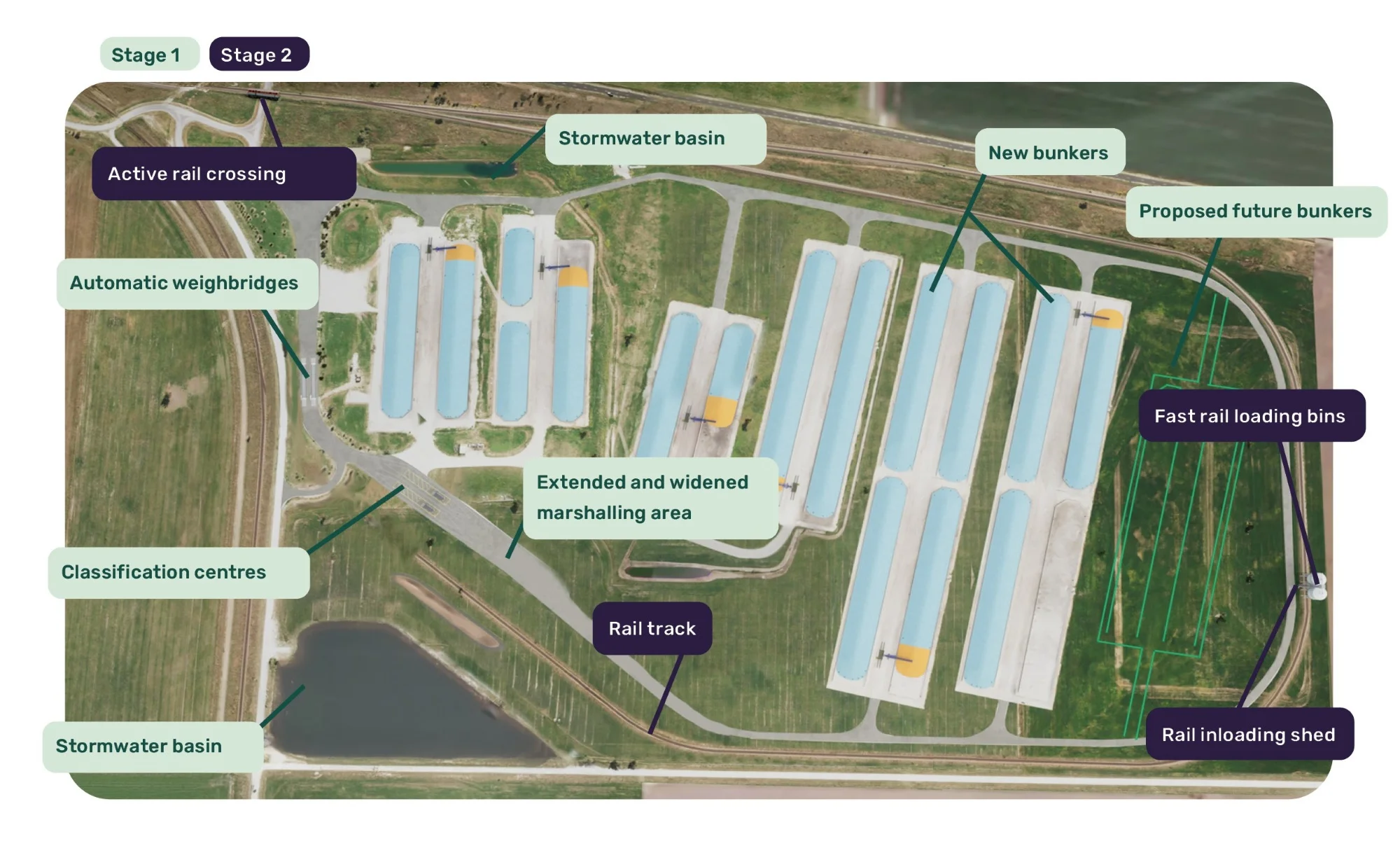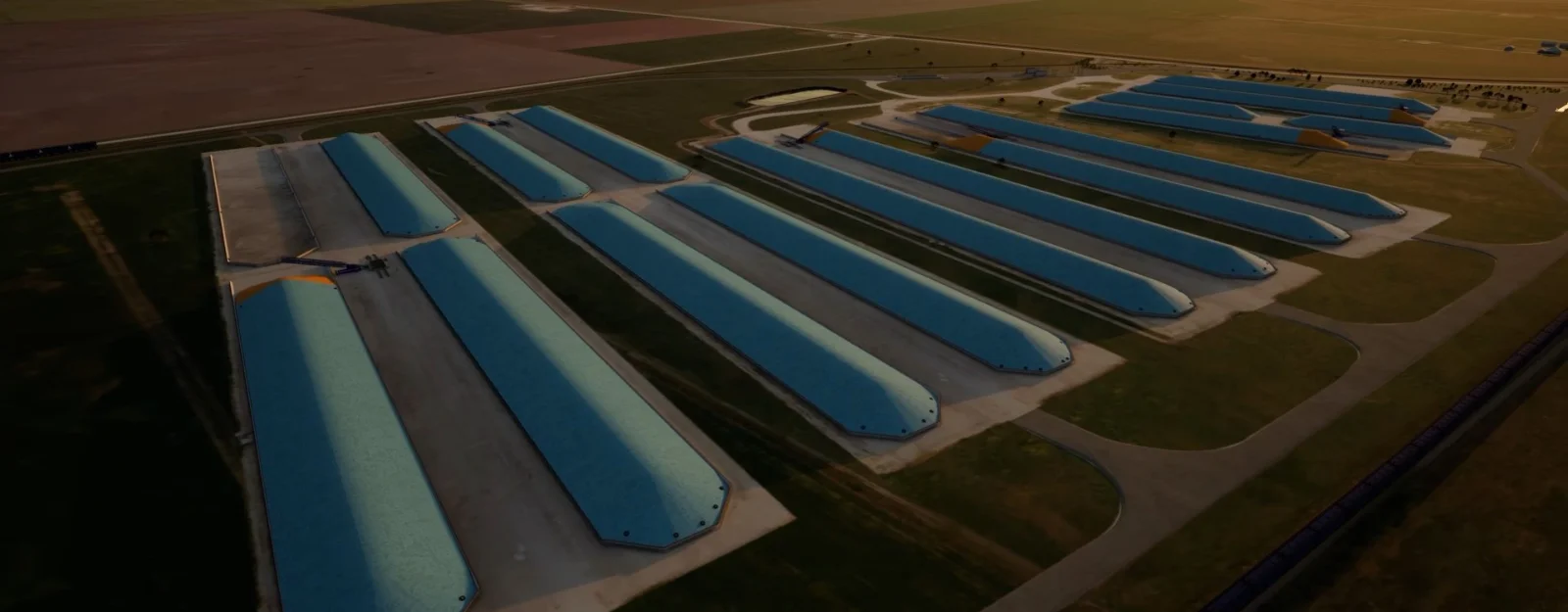Viterra is making a $35 million investment in our Wolseley site to improve safety, expand the site and create efficiencies and value for our grower and buyer customers and the local community.
This project is our single largest investment in our upcountry network and aims to meet the evolving needs of growers now and into the future.
It will improve the grower delivery experience with additional bunker storage, state of the art classification centres and new and extended weighbridges, marshalling areas and roadways.
It will also transition the site to fast rail loading which will provide reduced freight costs that we pass back to growers and help move more tonnes to our Adelaide ports for export in the first half of the year, assisting growers to achieve a premium for their grain. This part of the project is being delivered in conjunction with rail freight operator Aurizon.
Our Wolseley site is a key asset in the Viterra network. Being situated on the Melbourne to Adelaide freight rail line, it plays a significant role in supporting local grain growers in the south east region of South Australia, and western Victoria, and connecting them with domestic and international consumers.
This investment is in addition to the $75 million we currently invest into our sites each year where it provides the greatest value to our customers through creating efficiencies, improving reliability and ensuring the long-term sustainability of our network.
The project
Stage 1: improving the safety and efficiency of the delivery process for growers and carriers
-
larger marshalling area, to improve access to the site during peak harvest periods and prevent trucks queueing on the external road
-
two automatic weighbridges, with one new and one existing upgraded to 50 metres to meet increased truck sizes
-
two state of the art classification centres which will improve turnaround times onsite
-
automated samplers which provide a more accurate sample of growers’ grain
-
increasing storage capacity to 400,000 tonnes
-
upgrade to existing roadways and new roads to make it safer and easier for everyone to move around site
-
upgrade of the existing onsite stormwater system to limit run off into the council system
Stage 2: bringing fast rail loading to the site to be able move more grain to port to meet demand
- two rail bins to allow us to fill a 50 wagon train in under two hours, in comparison to the eight hours it currently takes at Wolseley
- an inload shed for trucks to fill the bins to allow all weather loading and prevent delays when moving grain to port
- construction of a rail track (managed by Aurizon), allowing trains to access the bunker site for continuous, effective loading
Proposed design

The benefits
This project is an important step in Viterra’s focus of making the South Australian supply chain more efficient to compete with interstate and international markets of Black Sea, Canada, US and South America. It’s one of the many long-term investments we’re making to strengthen our network to the benefit of growers, buyers, the community and industry.
| Local community |
|
|---|---|
| Growers |
|
| Buyers |
|
The timeline
This timeline is subject to change based on approvals and contractor availability.
| 2024 (complete) | ||
|---|---|---|
| June - July (stage 1) |
September - November (stage 1) |
|
|
stakeholder engagement works contracts awarded submit development application |
weighbridges, road works complete bunker site and stormwater works start |
| 2025 | |||||||
|---|---|---|---|---|---|---|---|
| January (stage 1) |
February (stage 2) |
March (stage 2) |
April (stage 1) |
May (stage 2) |
July | December (stage 2) |
|
| classification area works begin | stakeholder engagement | submit development application | classification area complete | works contracts awarded |
bunker site and stormwater complete (stage 1) rail track, fast loading bins, inloading shed works begin (stage 2) |
fast loading bins, inloading shed complete |
| 2026 | |
|---|---|
| January (stage 2) |
TBC (stage 2) |
| rail track with manual level crossing complete | active level rail crossing complete |
Stage 2 FAQs
Viterra has engaged a stormwater specialist to assess the existing and potential project-related stormwater impacts.
Management of stormwater from the site catchment area will include an upgrade of the site stormwater detention basin system to prevent uncontrolled stormwater runoff from the site and incorporate a proposed controlled discharge to the town stormwater system through the summer months.
In addition to this, the collected stormwater will be used for dust control and other operational uses onsite. The catchment areas external of the Viterra bunker site as part of the rail track works is not expected to increase the volume of water, however additional drainage infrastructure will be installed to maintain proper flows through the town system utilising the existing local discharge points.
These upgrades are being developed in conjunction with the Tatiara District Council.
We will apply appropriate mitigation strategies to reduce potential noise generated by operational activities, vehicle and rail movements. Viterra has engaged a noise specialist to assess the potential project related noise impacts.
We have put in place mitigation strategies to reduce potential dust generated by construction and project related vehicle movements.
We will provide a larger marshalling area, to improve access to the site during peak harvest periods and prevent trucks queueing on the external road.
The planned works for this project will not result in a significant impact on the visual amenity of the existing site as it is consistent with current site structure.
Viterra has engaged a heritage specialist to undertake a desktop assessment to determine the presence (and potential presence) of Aboriginal and/or historical heritage items of significance within the site.
Our construction environmental management plan will include details of the management and mitigation of unknown Aboriginal/historical sites and will outline the protocol for management of unanticipated finds.
Viterra has engaged a biodiversity specialist to assess the potential impacts to any threatened vegetation on site. Appropriate mitigation measures will be implemented to avoid or minimise potential impacts to biodiversity.
Construction vehicles will use approved traffic routes when travelling to and from site.
The extension of the rail track into and around Viterra’s bunker site will reduce train movements around the Wolseley town resulting in less movements and activations of the West Terrace crossing. A new active rail crossing will be installed across Ridgway Road to service the mainline and the new additional siding rail track improving road and rail safety in the area.
The project will be assessed via a Development Application under the Planning, Development and Infrastructure Act 2016. The relevant consent authority will be the District Council of Tatiara.
Key steps and timeframes:
- Complete environmental assessments (quarter 1 2025)
- Public consultation (quarter 1 2025)
- Submit development application (quarter 1 2025)
- Viterra respond to submission, if required (quarter 2 2025)
- Determination of development application (quarter 2/3 2025)
- Commence construction (quarter 3 2025).
